 |
|---|
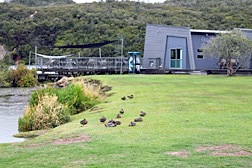 | It is cold and rainy as we leave Taupo and head northward to the Orakei-Korako Geothermal Attraction on the Waikato River. The name is Maori for "Place of Adornment," and the area is also known as "Hidden Valley." Even the ducks are taking a break from swimming and flying in this weather, but Pegah and I take a chance that the rain won't be ao bad it will spoil our visit. I had originally suggested a stop here basically because it was on our way, but Pegah seemed especially interested, so I was glad I scheduled it. What looks like a lava flow is the Emerald Terrace, produced by mineral-rich water from the many geysers. As the water cools, the minerals precipitate and form deposits that build up over time.
|
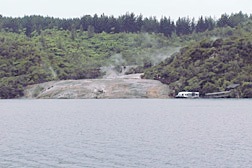 |
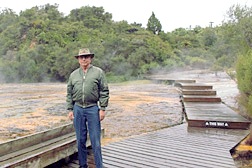 | The Emerald Terrace continues 115 feet under Lake Ohakuri, formed on the Waikato River by a hydropower generation dam in 1961. The dam raised the river level by 59 feet here, flooding approximately 200 alkaline hot springs and 70 geysers, two thirds of the active thermal area. Some of these thermal features still discharge, with their presence evident as gas bubbles rising from the vents in the lake bed. Here on the shore, the caretakers have constructed an extensive system of bridges and walkways that make it safe for visitors to cross the boiling discharges from the geysers still exposed. Here I am marveling at the dedication of the workmen who constantly braved the scalding water to build them. |
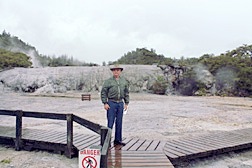 |
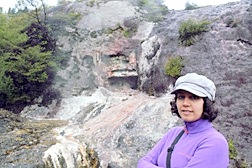 | Despite the loss of so many of its thermal features under the artificial lake, Orakei Korako remains the largest geyser field in New Zealand, with up to 35 active geysers. The most famous of these is the Diamond Geyser, whose unpredictable eruptions can last from a few minutes to many hours, ejecting boiling water as high as 30 feet. Here Pegah is posing near the three fault scarps formed by a massive earthquake in 131 AD, around the time when the Lake Taupo supervolcano was last erupting. They are mostly covered in hot water algae, or cyanobacteria, which grows in temperatures between 95-138 degrees Fahrenheit. The colors depend on the species, with green, yellow and black the most common.
|
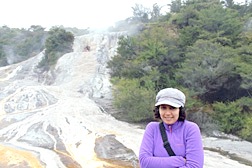 |
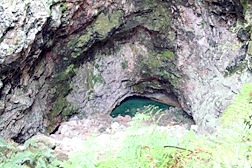 | One of the unique features of Orakei Korako is the Ruatapu Cave, one of only two caves in the world known to exist in a geothermal field. The cave extends 148 feet, with a vertical drop of 75 feet, to a shallow pool of clear, sulfate-rich, warm acid water. The water's chemicals give it the unique ability to clean jewelery. Another notable feature is the Soda Fountain, which burst into life in 1984 after a 17 year dormancy. To the south, high atop a cliff above the lake, are three further geysers, Kurapai, Ellan Vannin and Benedix Washer Geysers. The area is not accessible to the public because it is too dangerous. Boiling temperatures have been recorded there just 4 to 6 inches below ground.
|
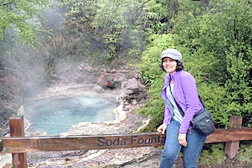 |
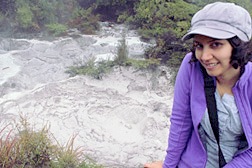 | The geysers, bubbling mud pools, and limestone deposits are dramatic evidence that the volcanic processes that formed North island are still occurring today. Two of the world's largest geysers were drowned by the hydropower dam in 1961: Minginui Geyser, which was once observed erupting up to 295 feet high (equal to the world's tallest today) and the Orakeikorako Geyser, which gave the region its name. Before the geothermal area was established as a visitor attraction in 1937, visitors crossed the river in a dugout canoe. In the 1930s, a cable and pulley system was erected to guide a boat propelled by the current. Today a power boat brings visitors back and forth across the lake. |
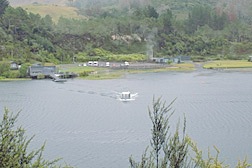 |
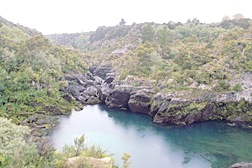 | Our next stop was the outfall of another one of the hydroelectric power stations on the Waikato. the Aratiatia Power Station. Before construction of the dam and power station, the Aratiatia Rapids were a prominent feature on the river. They now appear calm and tranquil, but several times a day the Arariaria dam gates are opened, which restores the rapids to their normal operation. This area was one used for the scene in The Hobbit where Bilbo and the dwarves float down the Forest River pursued by the orcs and defended by Legolas and Taurel. Reportedly, no actors were actually allowed in the river during filming because of the potential for injury when the flood gates were opened. |
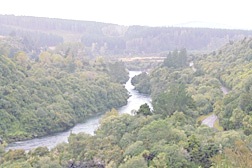 |
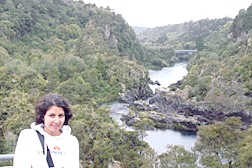 | There are several public lookout points on the high rock bluffs that dominate this turbulent stretch of the Aratiatia Rapids. Here at one of them is a good place to take a picture of Pegah against the background of the rapids. Unfortunately, we couldn't stay to see the flood gates opened because we were on a tight schedule to reach Matamata early enough to take some pictures before sunset. As a result, we didn't get to see the Waitomo Glowworm Caves or the Trollshaws of Denize Bluffs that I had included as places I wanted to visit. We did, however, arrive at Matamata in time to take some photos around the town and eat dinner so we could start out first thing the next day to visit Hobbiton.
|
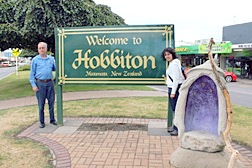 |
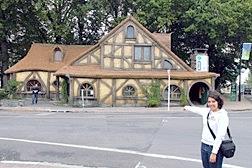 | With a total urban and rural population of about 12,000, Matamata is a thriving farming area formerly known for thoroughbred horse breeding and training. Originally, the nearby Hobbiton site was built only as a remote and temporary movie set. It was to have been returned to its natural state when finished, but the New Zealand government decided to leave the dismantled set as a tourist attraction. Beginning in 2010, parts of Hobbiton were rebuilt to provide a permanent tourist attraction as well as a durable motion picture set. The Matamata i-Site has been completely rebuilt as well, and serves not only as a tourist information center, but a retail outlet for all sorts of hobbit memorabilia.
|
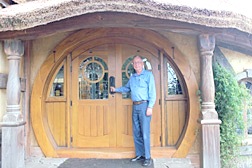 |
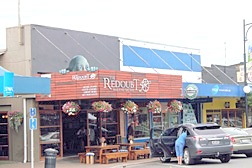 | Hobbit themes can be found throughout the town, with the Redoubt Bar and Eatery ("Good Food, Good Cheer, Great Beer, My Precious!") being a prime example. The interior is liberally decorated with reminders of The Hobbit films, and features homemade pizzas with names like "Smeagle's (sic) Catch" (smoked salmon), "Sauron's Fury" (chipotle lamb, chili and red onion) and "Frodo's Secret" (ham and mozzarella) and wines like "Lake Chalice Middle Earth." I thought the pizza names were a little "over the top," but the restaurant had a cozy, jovial atmosphere and friendly service. One of the employees took the picture of us at the "Welcome to Hobbiton" sign, above.
|
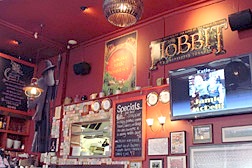 |
| Click here to go to the next page. |
|---|





































